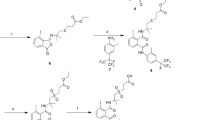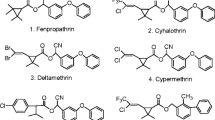Abstract
A bi-enzyme tracer direct competitive enzyme-linked immunosorbent assay (dc-ELISA) based on two generic antibodies was developed. The effects of several physicochemical factors, such as heterologous antigen–horseradish peroxidase (HRP), methanol concentration, ionic strength, and pH value, were optimized to obtain satisfactory sensitivity of the assay. Under the optimized conditions, the 50 % inhibition concentration (IC50) value for parathion, parathion-methyl, imidaclothiz, and imidacloprid was 57.28 ± 2.73, 169.82 ± 5.64, 52.48 ± 3.46, and 53.08 ± 2.05 μg L−1, with a limit of detection (LOD, IC10) of 0.56, 3.16, 0.62, and 0.51 μg L−1, respectively. There was no obvious cross-reactivity (CR) with most of the neonicotinoids and organophosphorus pesticides. The recoveries of parathion, parathion-methyl, imidaclothiz, and imidacloprid in environmental and agricultural samples, including river water, soil, and cabbage, ranged from 82.54 to 116.29 %. The relative standard deviation (RSD) ranged from 1.59 to 8.09 %. The ELISA results were confirmed by gas chromatography (GC) with a high correlation coefficient of 0.9882. These results showed that the bi-enzyme tracer competitive enzyme-linked immunosorbent assay could be used as a sensitive tool for monitoring parathion, parathion-methyl, imidaclothiz, and imidacloprid in environmental samples and agricultural products.





Similar content being viewed by others
References
Alcocer MJC, Doyen C, Lee HA, Morgan MRA (2000) J Agric Food Chem 48:4053
Arjmandi R, Tavakol M, Shayeghi M (2010) Int J Environ Sci Technol 7:175
Banks JN, Chaudhry MQ, Matthews WA, Haverly M, Watkins T, North Way BJ (1998) Food Agric Immunol 10:349
Buratti FM, Volpe MT, Meneguz A, Vittozzi L, Testai E (2003) Toxicol Appl Pharmacol 186:143
Černigoj U, Štangar UL, Jirkovský J (2010) J Hazard Mater 177:399
Duzguner V, Erdogan S (2010) Pestic Biochem Physiol 97:13
Fang S, Zhang B, Ren KW, Cao MM, Shi HY, Wang MH (2011) J Agric Food Chem 59:1594
Gajbhiye VT, Gupta S, Gupta RK (2004) Bull Environ Contam Toxicol 2:283
Gorman K, Liu Z, Denholm L, Brüggen K, Nauen R (2008) Pest Manag Sci 11:1122
Hua XD, Wang LM, Li G, Fang QK, Wang MH, Liu FQ (2013) Anal Methods 5:1556
Jia GF, Lv CG, Zhu WT, Qiu J, Wang XQ, Zhou ZQ (2008) J Hazard Mater 159:300
Jin RY, Guo YR, Wang CM, Wu JX, Zhu GN (2009) J Food Sci 74:T1
Kim YJ, Kim YA, Lee YT, Lee HS (2007) Anal Chim Acta 591:183
Lee JK, Anh KC, Park OS, Ko YK, Kim DW (2002) J Agric Food Chem 50:1791
Li K, Li QX (2000) J Agric Food Chem 48:3378
Liang CZ, Jin RY, Gui WJ, Zhu GN (2007) Environ Sci Technol 41:6783
Liu YH, Wang CM, Gui WJ, Bi JC, Jin MJ, Zhu GN (2009) Ecotoxicol Environ Saf 72:1673
Liu ZJ, Li M, Shi HY, Wang MH (2013) Food Anal Methods 6:691
Mercader JV, Parra J, Esteve-Turrillas FA, Agulló C, Abad-Somovilla A, Abad-Fuentes A (2012) Food Control 26:162
Miyake S, Beppu R, Yamaguchi Y, Kaneko H, Ohkawa H (1998) Pestic Sci 54:189
Nunes GS, Toscano IA, Barcelo D (1998) TrAC Trends Anal Chem 17:79
Roex EWM, Keijzers R, Gestel CAM (2003) Aquat Toxicol 64:451
Sathe M, Merwyn S, Ghorpade R, Agarwal GS, Rao MK, Rai GP, Kaushik MP (2011) J Hazard Mater 192:1720
Schenider P, Goodrow MH, Gee SJ, Hammock BD (1994) J Agric Food Chem 42:413
Skerritt JH, Hill AS, Beasley HL, Edward SL, Mcadam DP (1992) J AOAC Int 75:519
Sun JW, Dong TT, Zhang Y, Wang S (2010a) Anal Chim Acta 666:76
Sun JW, Zhang Y, Wang S (2010b) Food Addit Contam Part A 27:338
Wang S, Allan RD, Skerritt JH, Kennedy IR (1998) J Agric Food Chem 46:3330
Wang LG, Liang YC, Jiang X (2008) Bull Environ Contam Toxicol 4:377
Wang CM, Li XB, Liu YH, Guo YR, Xie R, Gui WJ, Zhu GN (2010) J Agric Food Chem 58:5658
Wengatz I, Stoutamire DW, Gee SJ, Hammock BD (1998) J Agric Food Chem 46:2211
Wu M, Cai JG, Yao JY, Dai BJ, Lu YT (2010) Bull Environ Contam Toxicol 3:289
Xu ZL, Xie GM, Li YX et al (2009) Anal Chim Acta 647:90
Yan X, Shi HY, Wang MH (2012) Anal Methods 4:4053
Zeng DY, Shi HY, Li B, Wang MH, Song BA (2006) J Agric Food Chem 54:8682
Zhang FZ, Li YJ, Yu CS, Pan CP (2012) Bull Environ Contam Toxicol 88:885
Acknowledgments
This work was supported by the National “863” High-Tech Research Program of China (no. 2011AA100806) and the Special Fund for Agro-scientific Research in the Public Interest (no. 201203022).
Compliance with Ethics Requirements
Xu Yan and Minghua Wang designed the study and supervised Xu Yan and Xiaojian Tang in conducting all the experiments, discussed the results, and prepared the manuscript. Xu Yan, Xiaojian Tang, Hongxia Li, Enze Sheng, and Dongdong Yang participated in preparation of protein conjugates and discussion of the results. Xu Yan and Xiaojian Tang prepared the antibody and conducted the assay development.
Conflict of Interest
Xu Yan (first author) declares that he has no conflict of interest. Xiaojian Tang (second author) declares that he has no conflict of interest. Hongxia Li (third author) declares that he has no conflict of interest. Enze Sheng (fourth author) declares that he has no conflict of interest. Dongdong Yang (fifth author) declares that he has no conflict of interest. Minghua Wang (corresponding author) declares that he has no conflict of interest. For any studies with animal subjects in this article, all institutional and national guidelines for the care and use of laboratory animals were followed.
Author information
Authors and Affiliations
Corresponding author
Rights and permissions
About this article
Cite this article
Yan, X., Tang, X., Li, H. et al. Rapid Detection of Four Organophosphorous and Neonicotinoid Toxicants Using Bi-enzyme Tracer Competitive Enzyme-Linked Immunosorbent Assay. Food Anal. Methods 7, 1186–1194 (2014). https://doi.org/10.1007/s12161-013-9732-3
Received:
Accepted:
Published:
Issue Date:
DOI: https://doi.org/10.1007/s12161-013-9732-3




